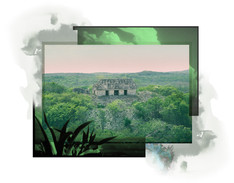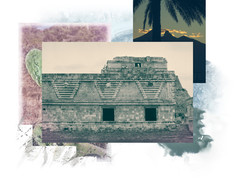Miguel Soler-Roig
visual artist
The Ruin of Memory









In the navel of the moon
Miguel Soler-Roig brings together landscape photographs taken in Mexico over a period of more than 30 years. The images are divided into two series: the beginning and the present of the author's relationship with the country, without forgetting the emotional density that runs through the entire interval from the centre of his biography.
The artist recovers the Nahuatl origin of Mexico to generate subtle links between the mythical etymology of the territory and the character of his own vital milestones. The name comes from the union of three words -metztli (moon), xictli (navel) and co (place)- and responds to the similarity between the shape of the ancient lakes of the valley of Mexico and the silhouette of the lunar spots seen from the earth. These references place us in a symbolic key related to the moon and water and, therefore, to emotions, the past and the subconscious, fundamental elements of the exhibition. Soler-Roig immerses himself in his extensive photographic archive and lets himself be carried away by an intuitive process that leads to a visual and affective synthesis materialized in two works.
The first consists of digital collages from slides of his first trip in 1986, when he was a teenager. The images reflect the irregular succession of stages in Mexico through various intensities and juxtaposed elements. They all start from an ancient record of archaeological ruins and are layered, like a palimpsest, with liquid resources and private photographs linked to a memory. Each composition is a compendium of crossed experiences anchored in a past time.
The enclaves are located, with the exception of the Popocatepetl volcano, in the Yucatan Peninsula: the Tulum Castle, the monuments of Uxmal and the summit of the temple of Kukulcan in Chichen Itza (Mayan version of the feathered serpent or Quetzalcoatl). This photograph serves as a transition to the second room, a sort of dark chapel with four immense landscapes in which to immerse ourselves. Each one of them is the aesthetic conclusion of one of Soler-Roig's last revealing experiences in Mexico, those that have managed to take him to his inner epicenter: a meditative impasse, a moment of identity celebration, a spiritual journey mediated by plants or the sensation of unity with the cosmos. The horizons of magical atmospheres and nature in its wild state express the intertwining between the physical realities of the Mexican environment and the author's subjectivity.
En el ombligo de la luna
Miguel Soler-Roig reúne fotografías de paisajes realizadas en México a lo largo de más de 30 años. Las imágenes se dividen en dos series: el inicio y la actualidad de la relación del autor con el país, sin olvidar la densidad emocional que atraviesa todo el intervalo desde el centro de su biografía.
El artista recupera el origen Náhuatl de México para generar sutiles vínculos entre la etimología mítica del territorio y el carácter de sus propios hitos vitales. El nombre proviene de la unión de tres palabras –metztli (luna), xictli (ombligo) y co (lugar) y responde a la similitud entre la forma de los antiguos lagos de la cuenca de México y la silueta de las manchas lunares vistas desde la tierra. Estas referencias nos sitúan en una clave simbólica relacionada con la luna y el agua y, por lo tanto, con las emociones, el pasado y el subconsciente, elementos fundamentales de la muestra. Soler-Roig se sumerge en su amplio archivo fotográfico y se deja llevar por un proceso intuitivo que desemboca en una síntesis visual y afectiva materializada en dos trabajos.
El primero consiste en collages digitales a partir de diapositivas de su primer viaje en 1986, siendo un adolescente. Las imágenes reflejan la sucesión irregular de etapas en México a través de varias intensidades y elementos yuxtapuestos. Todas parten de un registro antiguo de ruinas arqueológicas y son intervenidas por capas, cual palimpsesto, con recursos líquidos y fotografías privadas ligadas a un recuerdo. Cada composición es un compendio de experiencias cruzadas que tiene su anclaje en un tiempo pretérito.
Los enclaves se sitúan, a excepción el volcán Popocatépetl, en la península del Yucatán: el Castillo de Tulum, los monumentos de Uxmal y la cumbre del templo de Kukulcán en Chichén Itzá (versión maya de la serpiente emplumada o Quetzalcóatl). Esta fotografía sirve de tránsito a la segunda sala, una suerte de capilla oscura con cuatro inmensos paisajes donde sumergirnos. Cada uno de ellos es la conclusión estética de una de las últimas vivencias reveladoras de Soler-Roig en México, aquellas que han conseguido trasladarle hasta su epicentro interno: un impase meditativo, un momento de celebración identitaria, un viaje espiritual mediado por plantas o la sensación de unidad con el cosmos. Los horizontes de atmósferas mágicas y naturaleza en estado salvaje expresan el entrelazamiento entre las realidades físicas del entorno mexicano y la subjetividad del autor.